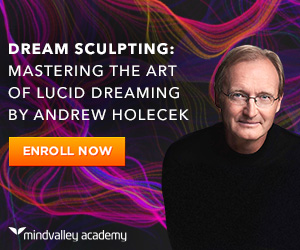The Art of Lucid Dreaming:
3 Powerful Induction Techniques for Consciously Controlling Your Dreams
BY ANDREW HOLECEK
 lucid dreaming induction techniques allow you to become conscious and aware while dreaming giving you new layers of insight into your own consciousness and reality itself.
lucid dreaming induction techniques allow you to become conscious and aware while dreaming giving you new layers of insight into your own consciousness and reality itself.
What Is a Lucid Dream?
Lucid dream is a term hinted at by the scholar Marquis d’Hervey de Saint-Denys (1822–1892), but which was coined by the Dutch psychiatrist Frederik van Eeden (1860–1932). In the West, lucid dream techniques go back as far as Aristotle, with the first Western lucid dream report written in 415 CE by Saint Augustine. A lucid dream is when you wake up to the fact that you’re dreaming, but you still remain in the dream—
that is, you’re dreaming and you know it. The validity of lucid dreaming was scientifically proven in 1975 by the psychologist Keith Hearne at Hull University and then independently by Stephen LaBerge in l977 at Stanford. LaBerge is arguably the father of modern lucid dreaming, and his books Lucid Dreaming: The Power of Being Awake and Aware in Your Dreams (1985) and Exploring the World of Lucid Dreaming (1990, coauthored with Howard Rheingold) are classics. Prior to these pioneering studies, the idea of “lucid dreaming” was mostly dismissed by the scientific community. How can you be awake and dreaming at the same time? LaBerge and Hearne proved that you can, and lucid dreaming gained a foothold in the West.In that magical instant of awakening within the lucid dream, everything changes. What just a moment ago had total control over you now comes under your control. Instead of being blown around helplessly by the dictates of the dream, you now dictate the dream. You can do whatever you want, and no one can see you. You can fly, have sex with a movie star, or rob Fort Knox.
Dreams are truth-tellers. They reveal our deepest unconscious tendencies, as any psychologist or dream recall interpreter can attest. This same maxim applies to working with lucid dreams on a spiritual level. The moniker for dream yoga in the classic texts is “the measure of the path.” Dream yoga will show you a great deal about who you are, and where you stand on the path.
Try this brief contemplation, and be ruthlessly honest: What would you do if you could become invisible? What might that reveal? Would you act selflessly or selfishly? Plato addressed this issue in The Republic, where he talks about the “Myth of the Ring of Gyges.” In this myth, the shepherd Gyges discovers a magical ring that gives him the power of invisibility. Plato uses this myth to talk about morality—what would you do if you were invisible and nobody could hold you accountable for your actions? Would you work to benefit others (which, in Buddhist terms, would reveal an evolved being with a purified mind), or would you fulfill your wildest fantasies (which would reveal a normal being with a defiled mind)? Gyges used his invisibility to fulfill his raw desires. Lucid dreaming techniques give you a chance to live the myth of Gyges, and to learn from it.
Lucidity is not an “all-or-nothing” affair. There is a spectrum ranging from barely lucid to hyper-lucid, and from the shortest flashes of lucidity to lucid dreams lasting over an hour. For example, being barely lucid might involve acknowledging on some level that you’re having a lucid dream, but not acting with full comprehension. You might still flee from perceived danger or treat dream characters as if they were real. Hyper-lucid dreaming would be full comprehension of the dreamlike nature of your experience in the dream, recognizing that even the sense of self in the dream is being dreamt. Hyper-lucidity could also refer to colors and forms in the dream that seem more vibrant and real than anything in waking experience. You can also be non-lucid in a dream, become lucid to it, then drop into non-lucidity again.
The good news about lucid dreaming and the techniques to experience them is that even though it may take practice to induce such dreams regularly, it just takes one instant of recognition and you’re “in.” One flash of recognition transforms a non-lucid dream into a lucid one. I’ve been to many lucid dream seminars where people get discouraged by their inability to trigger lucidity, but then the next night it suddenly happens. That single instance is often enough to ignite a passion for lucid dreams. There’s nothing quite like a lucid dream, and when you have one, it’s irresistible to want more.
Facts and Figures
Here are some general facts about lucid dreaming: Young children tend to have lucid dreams more frequently, an occurrence that drops off around age sixteen. Younger people in general are more likely to induce lucid dreams than older folks. Lucidity occurs as early as age three, but it seems most likely to happen around ages twelve to fourteen. On average, lucid dreamers have three to four lucid dreams each month, with the average length of lucidity being about fourteen minutes. Some 58 to 70 percent of people will have at least one lucid dream during their life.
The benefits of lucid dreaming are remarkable. Here’s a sampling:
Lucid dreaming can aid with nightmares and depression. Up to 8 percent of adults suffer from chronic nightmares. In a study at Utrecht University in the Netherlands, participants underwent lucid dreaming treatment (LDT), which included coming up with alternative endings to their nightmares. Those who were able to do so reduced their nightmares.
Lucid dreams can boost your confidence, help you overcome shyness, manage grief, and give you the chance to rehearse things like a performance or presentation. They can also prepare you for events you expect to be emotionally difficult, by giving you the chance to experience them in your dreams in advance of the actual worldly event. For example, a friend of mine was able to prepare for her mother’s approaching death by practicing lucid dreaming techniques and having dreams about that sad event and using those as opportunities to practice letting go. This form of anticipatory grief can soften the blow of real grief.
Lucid dreamers may be better at solving problems according to recent studies. In some problem-solving situations, people need to “step back from perceived reality, reflect on it, and evaluate the perceptual evidence,” write the authors of this study. How does this connect to lucidity in dreams? The same authors continue, “For the insight that leads to lucidity, people also seem able to step back from the obvious interpretation and consider a remote and, at the time, implausible option—that it is all a dream.” In other words, new perspective can be innovative. The biggest problem of them all is samsara, which is the confused world of conventional reality defined by dissatisfaction and suffering, and lucid dreaming techniques have the potential to solve even that.
 lucid dreaming techniques usually require a little practice, but the rewards are immense—opening us to whole new worlds of rich, transformative experience. photo: tyler mullins
lucid dreaming techniques usually require a little practice, but the rewards are immense—opening us to whole new worlds of rich, transformative experience. photo: tyler mullins
Lucid dreaming has been shown to improve motor skills, which means it has the ability to help you with any physical activity, from playing the piano to athletic performance. It makes sense, because lucid dreams activate the brain in the same way as waking life. If you work on a math problem in your dream, for example, your left hemisphere is stimulated just as it would be during the day. If you sing in your dream, the right hemisphere is activated. If you do squats in a lucid dream, your physical heart rate increases. The extraordinary thing is that the effects from your nightly activity continue into the day. Training your dream body can train your physical body. For those with no time left during the day to do things, it’s like adding a night shift.
Lucid dreaming can facilitate healing. One doctor published a paper about a patient with a twenty-two-year history of chronic pain who cured himself overnight with a single lucid dream. “I’m no expert on lucid dreams,” says physiatrist Mauro Zappaterra. “But the man woke up with no pain. He said it was like his brain had shut down and rebooted. A few days later, he walks in the VA pharmacy and actually returns his medication—300 tabs of levorphanol. To me that’s pretty convincing evidence.” Lucid dreaming techniques are becoming the latest rage. People are using it to get an edge on their competition. Researchers are working with it to treat PTSD. Sleep scientists in Germany are using it to enhance focus and performance in athletes. Actors, inventors, artists, writers, and musicians are increasingly practicing lucid dreaming to enhance creativity. The psychologist Janine Chasseguet-Smirgel writes, “The process of creation [is] accompanied by the capacity to communicate with the most primitive layers of the unconscious”—layers of the unconscious that can be recalled in your dreams.
Lucid dreaming in general has been connected to creativity for eons, and the literature is replete with examples. The German chemist Friedrich Kekule discovered the molecular structure of benzene in a dream, James Cameron’s dream of a robot-man eventually became the movie The Terminator, Robert Louis Stevenson came up with the plot for his novella The Strange Case of Dr. Jekyll and Mr. Hyde in a dream, and Paul McCartney’s song Yesterday came to him in a dream.
The current popularity of lucid dreaming techniques is both a blessing and a curse. The curse is that dreams, as being unreal, are often not taken seriously. Cultures that honor dreams are often dismissed as primitive. “It’s just a dream” is a trivializing comment, albeit one with provisional validity. But if we dismiss our dreams and discharge lucid dreaming as just another virtual reality game, we will dismiss a profound opportunity to explore the nature of mind and reality. The truly primitive cultures may well be those that dismiss the power of dreams, and therefore ignore the unparalleled opportunities for growth.
We’re going to talk about how to strengthen the world of lucid dreaming as a way to weaken the world of daily appearance, so that worldly things don’t have as much power over us. In technical terms, we can almost say that we’ll reify, or materialize, the dream world in an effort to de-reify, or dematerialize, the waking world—until both are seen as equally real or unreal, and we awaken to the illusory nature of both. That’s where freedom lies, and that’s what “waking up” in the spiritual sense means.Western Lucid Dream Induction Techniques
From the trivial to the transcendent, lucid dreaming is a spectrum of experience mostly concerned with worldly matters and self-fulfillment. Going deeper, lucid dreaming can develop into dream yoga, and become a spiritual practice. This is not to say that lucid dreaming isn’t spiritual. It can be. But as a practice, and in contrast to dream yoga, lucid dreaming doesn’t have as many spiritually oriented methods. “Yoga” is that which yokes, or unites. Dream yoga unites you with deeper aspects of your being; it is more concerned with self-transcendence.
Dream yoga itself hasn’t changed much in hundreds of years. It was designed by beings so awake that perhaps they didn’t realize that mere mortals like ourselves might need some baby steps. The classic practice texts are pithy and therefore steep. The great contribution of modern lucid dreaming is to provide a gradual on-ramp. It’s a beautiful example of merging ancient and modern, East and West. Lucid dreaming has much to offer for practitioners of dream yoga, and dream yoga has a great deal to contribute to lucid dreaming. Together they make fantastic sleeping partners.
Here I will introduce a variety of lucid dream induction techniques. There is no need to master them all. Inducing lucidity is the point, not the lucid dream technique that gets you there. We’re all different. One technique may work for one person and not at all for another. The point in presenting all these dreaming techniques is that you will eventually find one that works for you. When you do, stick with that if you wish. No need to do any other unless you wish to explore more possibilities. The only danger in presenting so many methods is that you might try one for a night or two, give up, and then skip to the next. I recommend staying with a technique for at least several weeks. Give it a chance. If it’s not working after that, then try another. And feel free to start with whichever particular method makes the most sense to you.
There’s a story about a farmer who wanted to dig a well. He tried to find water by digging six feet in one spot, at which point he got discouraged and moved to try another spot. He dug another six feet, got nothing, and moved to another location and then another. His lack of perseverance guaranteed failure. To get to the center of yourself with these nocturnal meditations, you have to dig deep. Potshots create potholes that will never reach far.
What makes dream yoga unique is that you become your own instructor. You’re the one who knows your mind better than anyone. You’re the one who knows your sleep patterns and lucid dream quirks. You have to be honest with yourself in this practice, which is another instance of the nighttime practices as truth-tellers. You have to rely on your own wisdom and take responsibility for your success.
See what works for you not only in the lucid dreaming techniques themselves but in the way you employ them. If you find it’s too disruptive to practice lucid dreaming during the week, then just do it on weekends. While it’s helpful at first to do a technique the way it’s presented, don’t be afraid to play around with it. Maybe a blending of techniques works for you, or your own method. Experiment, and have fun. If you don’t enjoy lucid dreaming, you won’t do it. While motivation and ambition are important, don’t be hard on yourself. Go slow and easy.
The idea of the nighttime practices as truth-tellers applies to another issue. Sooner or later, these lucid dream techniques will reveal your passion for ignorance. There will come a point when you may say, “Screw it. I’d rather go to sleep.” Many times I don’t want to practice. I get lazy, or just don’t care. That’s when I notice my passion for ignorance and smile at it. It is a natural expression of our passion for mindlessness, as we will see. While there may be part of us that wants to wake up, there’s a big part of us that does not. For the ego, ignorance really is bliss. We’ve been spiritually asleep for a long time, and waking up isn’t always easy.
A central teaching in any meditation is “not too tight; not too loose.” If you’re too tight, or try too hard, you’ll tie yourself into knots and won’t fall asleep. If you don’t try enough, you’re too loose, and you’re not practicing lucid dream yoga. The “middle way” approach is always best. It’s like tuning a guitar. Tune it too tightly and the strings snap; tune it too loosely and it makes a saggy sound. With balance, perseverance, and humor, you will learn how to tune your mind to make beautiful night music.
Three Key Ingredients
The three essential ingredients for lucid dreaming are:
1. Strong motivation, or intention
2. Good dream recall
3. Practicing the induction techniques.
If you already possess the first two, you can skip to the lucid dream induction techniques below.
The first ingredient, strong motivation, is critical. Motivation, or intention, creates momentum that carries into the dream world. It’s as if you are seeding the lucid dream, a technique that is basic to any level of lucid dream induction. The word “intent” comes from roots that mean “to stretch toward” (in-, “toward,” and tendere, “stretch”). Lucid dreaming, or dream yoga, begins by stretching the mind with intention. As we have seen, stretching is common to both mental and physical yogas. In order to wrap your mind around the dark, you have to stretch toward it. You eventually want to stretch your awareness into previously unconscious states of mind, and the warm up for that begins with your intent. Stretching in this intentional way therefore begins to expand your mind.
Have you ever had to get up early and not had an alarm clock? By setting a strong intention to get up at a certain time, we often wake up at that time despite not having an alarm. In the same way, we can set an internal alarm to wake us up within a lucid dream by setting a strong intention.
If you’re reading this, you’ve already started to set your intent. Studying the view, or philosophy, behind lucid dreaming and dream yoga strengthens it. To actually practice intention, say to yourself throughout the day, “Tonight I will remember my dreams. I will have many dreams. I will have good dreams. I will wake up within my dreams.” Don’t just mouth the words. Mean it. You also strengthen the intention by saying it out loud and writing it down: taking it from mental to verbal to physical. As you’re lying down in bed, ramp up your intent like a sprint to the finish line.Other expressions of intent come from reading books, taking courses, and basically spending as much time as you can with this material. When Stephen LaBerge was doing his PhD dissertation on lucid dreaming tehcniques, he was soaking in this material and had lucid dreams almost every night. My own work in writing my book has been similar. Plant lots of seeds, and you’ll harvest lots of plants. Do not underestimate the power of intent. The lucid dream researchers Robert Price and David Cohen write, “Lucid dreaming appears to be an experience widely available to the highly motivated.” One way to sustain motivation and intent is to have a clear goal once you do become lucid. In lucid dreaming workshops, people often say, “My goal is to become lucid in my dreams!” When they do, they often immediately wake up and feel disappointed because the lucid dream didn’t last. Why should they be disappointed when they attained their goal? They got what they asked for, so the key is to ask for more. It’s therefore important to set a goal beyond becoming lucid, so that lucidity eventually becomes the natural state, the platform, that’s required to accomplish even higher goals.
Patricia Keelin, an elite lucid dreamer, says that the more emotionally imbued the goal is, and the stronger the motivational charge, the greater the reach. For example, if you go to sleep with the passion, excitement, and anticipation that “I will wake up in my dreams because I want to fly. I want to feel the freedom of soaring through space, to see from a bird’s-eye view, and to feel the wind blowing through my hair!” you’ve added octane to your intent. The key is to add the magical element of feeling, or emotional charge. So extend your intent even further into the dream world, “stretch toward” more by infusing your motivation with passion. It’s amazing how often you’ll get what you really ask for.
A second essential ingredient for lucid dreaming is good dream recall. Even though we have at least six dreams each night, many people don’t remember any of them. LaBerge says that until you can remember at least two dreams each night, it’s better not to try the lucid dream techniques.
Good dream recall begins with your attitude, which follows from motivation and setting the intent to remember your dreams.
Value your dreams, and then plant the seeds for better recall. If you make your dreams important, they will come to you more frequently. As the dream researcher Patricia Gareld says in her book Creative Dreaming, “Those who do not ‘believe in’ lucid dreams or who believe them to be nonsense do not remember their dreams or have only nonsensical ones. Dreams are what you make of them… Dream states respond to waking attitudes.” Tell yourself resolutely that you will remember your dreams. Put your heart into it. Get plenty of sleep, and allow yourself to sleep in. Take advantage of prime-time dream-time. The fun part of lucid dreaming is giving yourself permission to languish in bed, and dip in and out of dreams.
Dream journaling, or a dream diary, really helps. Starting a dream journal highlights the intention that you’re taking this seriously. You’re putting your money where your mouth is. You’re also progressing from mental (the intent), to the verbal (repeating the intention to remember dreams), to the physical (getting the journal). Gareld quotes the anthropologist Tanya Luhrmann, who recalled, “Many years ago, I joined a group that decided that we would write down our dreams. And my dream life changed. I seemed to dream more. I remembered more detail. I sometimes had dreams of mythic intensity.” If you have a hard time recalling dreams, it helps to write down any snippet of any dream you can remember. When you wake up, ask yourself, “Was I dreaming?” Close your eyes and try to return to recapture any part of the dream. And don’t move. Moving engages waking consciousness and pulls you out of the dream world. If you’ve already moved and think you did have a dream, return to the position you were in when you first woke up. Memories are lodged in our bodies. I have often recalled a dream by returning to the position I was in when I had it.
Here’s a daytime practice to support your lucid dream techniques. Set a timer to go off at random intervals throughout the day. When it signals, take a moment to recall your thoughts or actions from the past ten minutes. You can also adapt this type of mental backtracking to occasions when you find you’ve been daydreaming. This is in the family of “reciprocating practices,” which means that the practice you do during the day will help you with your practice at night; and the practice you do at night will help you with your practice during the day. This type of back-and-forth, or bidirectional, practice is common in dream yoga. You’re opening up a two-way street between the day and the night.
Finally, take advantage of prime-time lucid dreaming by waking up about two hours before you normally would, staying up for fifteen minutes or so, then going back to sleep. With these tips it’s easy to start remembering your dreams. With strong motivation and good dream recall, you’re ready to explore the third ingredient, the lucid dream induction techniques, which I’ll divide into the daytime and nighttime methods.
Waking Up and the Reassembly of Self
Waking up in the middle of the night can also be illuminating in terms of how we create, or reconstitute, our sense of self in lucid dreams. I often find that when I first wake up, especially if it’s from deep dreamless sleep in the middle of the night, that I can’t immediately locate myself. Sometimes literally, as in not knowing where I am, but most important ontologically, as in not knowing who I am. I’m obviously aware when I’m jolted awake, but I’m sometimes not aware of my personal identity or history.
You’ve probably had this unsettling experience. It takes a few revealing seconds to reconstitute the running narrative, the storyline, that ends up being “you.” In my experience, sometimes the feeling is groundless and panicky, and I scramble to re-create who I am. On those occasions, I breathe a sigh of relief when I finally “find” myself. At other times it’s fascinating not to locate my sense of self, and I delight in this gap of not knowing. During these more pleasant awakenings, I watch my mind bustle about as it puts together the jigsaw puzzle—all the separate pieces of my history—that results in this ineffable feeling called “me.” This is a glimpse of egolessness, and how my ego sometimes doesn’t like it. When I first wake up, there’s no reference point, no me. Just pure awareness free of any narrative. If I can stay open to that groundlessness and relate to it properly, without reference to anyone (me) having this experience, it’s a liberating and spacious feeling. But due to the power of habit, ego’s defensive and self-generating strategies, race to coalesce this open awareness into a contracted point that I then recognize as the historical me. I can literally feel this contraction in my guts. What I don’t feel, because it’s been happening for so long that I’ve grown accustomed or even anesthetized to it, is that this contraction doesn’t stop. It’s happening right now. I’m operating from this contracted and painful point all the time. It’s a point of pinched awareness called “me,” a defensive self-contraction against open space, or pure egoless awareness, that is born from my fear of egolessness, and combats the freedom I seek through lucid dreaming techniques.
The next time you wake up in the dead of night, or are otherwise jolted awake, try to relate to this jarring transition in consciousness in a new way. Feel the initial openness, the rapidly ensuing bewilderment, and the scramble to reassemble yourself. This kind of exploration is part of the nighttime dream yogas, which as a family of practices are ways to relate to any nighttime experience with a meditative and inquisitive attitude. You can learn a great deal about yourself as you fall (apart) into sleep, and come back (together) to waking consciousness.
Daytime Western Lucid Dream Induction Techniques
A host of daytime methods provide the on-ramp for the night-time techniques. These daily practices also help you mix dream yoga into your life, integrating these normally disparate states of consciousness.
1. State Checks
One useful daytime induction technique is to conduct regular “state checks.” A state check means you’re going to question the status of your reality by asking yourself throughout the day, “Is this a dream? Am I lucid dreaming?” as a way of developing a critical attitude toward your reality. It may seem silly to ask yourself these questions, because our usual response is, “Of course I’m awake!” But how do you know for sure?
A non-critical or unquestioning attitude causes us to miss the fact that we’re dreaming when we’re dreaming. We don’t realize that we’re dreaming because we take the dream to be real, when in fact it is not. That’s the very definition of non-lucidity—“mistaking” dreams to be real. Because we don’t question the status of our reality during the day, we don’t question the status of our reality at night. As you familiarize yourself with the practice of conducting state checks, the habit carries over into your dreams. When you apply it, you will suddenly discover that you are dreaming. That one flash of recognition is all you need to wake up in your lucid dreams.
Conducting a state check is easy. On the back of a business card write, “Is this a dream?” Look at it periodically during the day, then take it out of your line of vision, then look at it again. If you’re awake, the card will look the same the second time you look at it. But if you’re dreaming, something about the card will change. If the card comes back the second time saying something else, or is in a different font, size, or color, you can be pretty sure you’re lucid dreaming. You can do the same thing with a digital watch. Look at it, look away, then look again. Is it the same on second glance?
My favorite state check is also the easiest. Simply jump up periodically during the day. If you come back down, you’re probably awake. But if you keep going up, or come back down and fall through the ground, you’re lucid dreaming. I have used this countless times to trigger lucidity. Sometimes I’ll jump up and just keep going; other times I’ll start to come down, tuck my legs in as if I’m about to land on my knees, then bounce back up. These are things I can’t do in waking reality, so I’m clued in to the fact that I must be dreaming. It’s fun and it works. It’s like I’m skipping my way into lucidity.
2. The Myth of Knowledge
Conducting state checks points to a deeper issue, what the historian Daniel Boorstin calls “the illusion of knowledge.” “The greatest enemy of knowledge is not ignorance, it is the illusion of knowledge,” he writes. The world’s great discoverers have always needed “to battle against the current ‘facts’ and dogmas of the learned.” The illusion, or myth, of knowledge is one of our greatest obstacles because it’s so insidious. It’s a massive blind spot, or in our terms, an “asleep spot.” The myth of knowledge is when you’re certain you know something, but you actually don’t. It’s when you think something is a given, or axiomatic, but you’re wrong. Emotionally, it’s when you bang your fist on the table and proclaim, “That’s just the way it is!” But as Mark Twain put it, “It ain’t what you don’t know that gets you into trouble. It’s what you know for sure that just ain’t so.” In the world of lucid dreaming, the myth of knowledge is when you think you’re awake, but you’re actually dreaming. Being stuck in a non-lucid dream is falling victim to this myth. It can be a jolt to awaken from a dream that you thought was so real.
In Buddhism, the myth of knowledge is a central theme, and the awakening even more of a jolt. It’s when you think you’re awake but you’re actually asleep, in the spiritual sense. We’re all victims of this myth. That you’re awake right now just ain’t so. That things exist the way you think they do just ain’t so. Understanding the myth of knowledge is important on the path of waking up. As the philosopher of science Sir Karl Popper said, “It is through the falsification of our suppositions that we actually get in touch with ‘reality.’” When we conduct state checks, we’re taking the advice of the bumper sticker that exhorts us to “Question Authority.” We’re questioning the authority that what we’re experiencing is real. Our journey in this, ultimately, is to point out the illusion of knowledge and wake up from it. The futurist Alvin Toffler said, “The illiterate of the twenty-first century will not be those who cannot read and write, but those who cannot learn, unlearn, and relearn.” Our job here, as in life, is to unlearn and relearn. We need to strip away the myth that what we’re experiencing right now is real and to relearn that it’s actually just a dream. Or as Johann Wolfgang von Goethe put it, “None are more hopelessly enslaved than those who falsely believe they are free.”
3. Dreamsigns
Another daytime lucid dreaming technique that ties into state checks is to work with dreamsigns. Just like with state checks, you start by working with dreamsigns during the day and then extend the practice into the night. It’s both a daytime and nighttime practice, another reciprocating method. Working with dreamsigns means becoming sensitized to out-of-the-ordinary (dreamlike) events that occur during the day and to use those strange events as triggers to conduct state checks. A primary catalyst for triggering lucidity is noticing the dreamlike nature of your experience. This is in the category of what LaBerge calls a “dream-induced lucid dream,” which means you’re using the content of the dream to spark lucidity. We often wake up to the fact that we’re dreaming when we say to ourselves, “Wow, that’s really weird… I must be dreaming.” The strangeness clues us in. So during the day, if a bird hits your window, or a book falls off the shelf, jump up or otherwise ask yourself, “Is this a dream?” Anytime anything weird happens, ask yourself, “Is this a dream?” When we’re actually dreaming, we experience many anomalies, such as abrupt transitions of location, strange discontinuities, or bizarre occurrences. We might be flying, seeing pink elephants, or coming across any number of countless surreal events. If we take these in stride, as we usually do, we remain non-lucid. But if we condition ourselves to question reality when strange things happen, we condition ourselves to wake up within our dreams.
There are many kinds of dreamsigns. First are “weak” dreamsigns. These are highly improbable, but not impossible, events that occur in dreams. Seeing a strange dog walk into your dream house is weird, but not unheard of. “Strong” dreamsigns are things that can only happen in a dream, like when a chair turns into a boat or you find yourself flying. “Personal” dreamsigns are the most useful. These are common activities, situations, people, or objects that occur in your dreams, especially in recurrent dreams. This is where you take advantage of recurrent dreams. Record these activities, situations, people, or objects in your dream journal and become familiar with them. When they recur in your dreams, use your familiarization to trigger lucidity. For example, if you have a recurrent dream about your dead uncle, the only way he can appear to you as still alive is in a dream. Use his presence as a sign that you’re dreaming. “Dream themes” are connected to dreamsigns, and can also help you trigger lucidity. The idea is to become familiar with your repetitive dream themes: the environments, narratives, characters, objects, and actions that occur regularly. Do this by recalling your dream journal for repeated themes. If you have recurrent dreams about being chased, for example, or being late for a plane, use that theme to help you wake up to the fact that you’re dreaming. “Wait a second… I’ve been chased like this before… I must be dreaming.”
Dreamsigns and Death
Working with dreamsigns also helps us prepare for death. Tibetan Buddhists believe that one of the biggest problems we have after death is not realizing we’re dead, and dream yoga developed as a preparation for death. In bardo yoga, it is taught that there are classic death signs that can clue you into the fact that you’re dead. Once you wake up to the fact that you’re dead, you can use the many techniques of bardo yoga to help you during this challenging time, just like you would to induce a lucid dream.
The classic signs to look for to verify that you’re dead include: (1) you cast no shadow, (2) you look into a mirror or other reflecting surface and see no reflection, (3) you walk on sand or snow and leave no footprints, (4) your body makes no sound, (5) people don’t respond to you, (6) you can move unimpeded through matter, (7) you manifest miraculous power, such as the ability to fly, read minds, or travel very quickly, (8) you cannot see the sun or moon. These are also some of the same signs that can help you recognize that you’re lucid dreaming. Create the habit of checking for these signs now, and that habit will carry into dream and death. Remind yourself to look for your shadow, or to check for a reflection. Am I dead, dreaming, or alive and awake right now?
I regularly work with these death signs. When I’m outside on a sunny day I’ll check to see if I’m casting a shadow. I’ll look for footprints when I walk in the snow. It may seem strange, but it helps me develop the habit of questioning the status of my reality.
4. Prospective Memory
A general exercise and technique to induce lucid dreaming is the practice of “prospective memory.” Prospective (“of or in the future”) memory is remembering to do something in the future. It’s almost an oxymoron, because memory is associated with the past and prospective is associated with the future. When you’re trying to remember to wake up in a dream, which is a future event, you’re working with prospective memory, which can be strengthened with some exercises.
Once you get the gist of prospective memory exercises, the variations are infinite. The practice is to remember to do a state check whenever a specific event occurs. The event can be anything. For example, you could tell yourself that every time you see a cat, you will remember to do a state check. Or every time you hear a plane, a siren, or a dog bark, you will remember to do a state check. As your prospective memory develops, so will your ability to remember to wake up in your lucid dreams.
I recommend setting one different trigger event per day. Tell yourself that every time you get a text message today you’ll remember to do a state check. For the following day, every time you go to the bathroom, you’ll do a state check. Memory is a mental muscle you can exercise, and one that can lift you into lucidity.
5. State Checks and Priming: The Power of the Prime
Conducting state checks, or developing a critically reflective attitude, helps us interrupt the power of what psychologists call “priming.” Priming is just what it sounds like. It’s the mostly unconscious setup that predisposes us to see things a certain way. Priming is a fancy way to talk about expectation. If we start a sequence like 1, 2, 3, 4, 5, we are primed to expect that the next number will be 6. Our desires and expectations prime us to see what we want to see. We see the world the way we do, as solid, lasting, and independent, because we’ve been primed to do so by our parents, teachers, and virtually everyone alive. It’s this continued reinforcement that continues into the lucid dream state and primes us to see the dream as solid, lasting, and independent, and therefore non-lucid.
Priming is based on repetition, which is the essence of predisposition. We’re predisposed to non-lucidity at night because since early childhood we have been trained to see the world in a non-lucid way during the day. Daily dreamsigns and state checks use conscious priming to trigger alertness and awareness, lucidity instead of non-lucidity, and they do so by planting these new patterns for lucidity into the unconscious mind. We’re setting ourselves up to see the lucid dream as a dream.
Nighttime Western Induction Techniques
When you lie down to go to sleep, give one final push with your intention to wake up in your dreams. With as much heart as you can muster say, “Tonight I will have many dreams. I will have good dreams. I will remember my dreams. I will become lucid in my dreams.” How many times has your state of mind colored your sleep and dreams? If you go to sleep stressed or preoccupied with a particular state of mind, it often seeds your dreams. We dream at night what we think of during the day. In dream yoga, we want to seed the thoughts, delivered with the force of our intention, to wake up within our lucid dreams.
The “seeding” of our thoughts and intentions is the equivalent of what Buddhists call “karmic traces.” Tenzin Wangyal, in The Tibetan Yogas of Dream and Sleep (1998), says, “The karmic traces are like photographs we take of each experience. In the darkroom of sleep we develop the film.” Do you want to have certain dreams, or wake up in your dreams? Then take the proper photographs during the day.
1. Mnemonic Induction
LaBerge developed a particularly effective lucid dream technique that he called the “mnemonic induction of lucid dreams.” A mnemonic is a memory aid, and LaBerge got to the point with this technique where he could have lucid dreams at will. Mnemonic induction of lucid dreams employs prospective memory and is used after you wake from a dream at night and before you fall back asleep.
There are four steps to this lucid dream technique:
1. During the early morning, when you awaken spontaneously from a dream, go over the dream several times until you have memorized it.
2. Then, while lying in bed and returning to sleep, say to yourself, “Next time I’m dreaming, I want to remember to recognize I’m dreaming.”
3. Visualize yourself as being back in the lucid dream just rehearsed; only this time, see yourself realizing that you are, in fact, dreaming.
4. Repeat steps 2 and 3 until you feel your intention is clearly fixed or you fall asleep.
2. Electronic Aids
In 1985, LaBerge started designing a lucid dreaming induction device in the form of a comfortable sleep mask, a type of dream goggle. When sensors in the mask detect sufficient eye movement to indicate the REM stage of sleep, a cue is delivered via flashing lights, or sound, or both, to prompt the dreamer to become lucid. The cues enter your dream and become incorporated into it, helping trigger lucidity. It’s similar to what happens when it’s cold in your bedroom and you find yourself dreaming about snow or ice. Outside affects inside. I’ve used several versions of these lucid dream induction devices with good results.
A typical lucid dream where the light cue triggers lucidity might be me driving in a car and noticing that the vehicle in front of me is pumping its brake lights. Or, I’m standing under a street light that starts to flash. I’ll suddenly remember to associate the flashing light in my dream with the flashing light in the goggle, and I’m instantly lucid. The NovaDreamer designed by LaBerge can be adjusted to your style of REM sleep, and therefore customized for optimal use. With some personal experimentation, the device is fine-tuned to your particular dream patterns.
Scientists at the Goethe University Frankfurt in Germany were recently able to trigger lucid dreams in subjects by applying a mild electric current to their scalps. Researchers found that electrical stimulation in the 40 hertz (gamma) range applied to the frontal lobe “induces self-reflective awareness in dreams”—that is, lucidity. The lead investigator, Ursula Voss, says, “We can really quite easily change consciousness in dreams.” She recruited twenty-seven adults who had never experienced a lucid dream. Two minutes after reaching REM, the subjects received a weak electrical current (2 to 100 hertz) to the frontal lobe area for thirty seconds. The sweet spot was 40 hertz, which triggered their brains to produce brain waves at the same frequency and induced lucidity 77 percent of the time. When this technique is refined, it could be a revolution in lucid dream induction.
3. Galantamine
Galantamine is an effective substance for increasing lucid dream clarity, and therefore dream recall. In its prescription-strength form, galantamine was approved by the FDA in 2001 for the treatment of Alzheimer’s disease; it is sold under the names Razadyne, Reminyl, and Nivalin. In its over-the-counter form you can find it as Galantamind. It’s been used in Eastern Europe and Russia since the 1950s for the treatment of various neurological disorders. Galantamine is an alkaloid extracted from the snowdrop daffodil and spider lily, which are in the Amaryllidaceae (amaryllis) family of flowering plants. It was reportedly used 3,200 years ago by the Greek hero Odysseus, the hero of memory and the enemy of forgetfulness.
Many have used galantamine with great success. But some of my lucid dream colleagues report no luck, or even restless sleep, as the result of taking it. As with so many induction methods, results may vary.
Galantamine works by inhibiting the breakdown of the neurotransmitter acetylcholine, which is important in generating and maintaining REM sleep. Acetylcholine also supports memory. By keeping more of this neurotransmitter active in your brain, you tend to have clearer and more stable lucid dreams. The standard dosage for lucid dreamers is 4 to 8 milligrams about six hours after you go to sleep, which means most people get up and take it around two hours before they normally wake up, then go back to sleep. This is perfect, because it also works with prime-time dreamtime. Try 4 milligrams and see what happens. If there are no results, increase the dosage to 8 milligrams.
Galantamine is often mixed with choline bitartrate, creating the perfect lucid dream cocktail. I have never experienced side effects but, in its prescription strength, the side effects of galantamine include nausea, vomiting, dizziness, diarrhea, headache, decreased appetite, and decreased weight. It’s not to be used in pregnant or lactating women, those dealing with depression, or those sensitive to galantamine, choline, or pantothenic acid. In its over-the-counter form, galantamine is dispensed in an unregulated industry, which means you never know what you’re getting. One has to trust the manufacturer, and there are studies showing that nonregulated supplements are sometimes not what they profess to be. But in my experience, I do notice a difference in my dreams when I take confirmed doses, and no difference when I’ve taken a placebo.
I only use galantamine for an occasional boost and do not recommend regular use. It’s better to rely on other methods, especially the meditative tools described later. But galantamine does have its place in lucid dreaming. As with any supplement, use it but don’t abuse it.
Lucid Dream Induction Tips and Tricks
If you’re really inspired, set your alarm to go off every ninety minutes during the night, which is when you’re most likely to be in REM sleep. Once you’re awake, practice mnemonic induction of lucid dreams if you’ve awoken from a dream, or reset your intention to become lucid. Perhaps the single best tip is to set your alarm to go to about two hours before you would normally wake up, stay up for around thirty minutes, then go back to sleep. This method remains very effective for me, and it doesn’t disrupt my sleep. You can increase the likelihood of lucidity twenty-fold with this step alone. A number of dream researchers assert that joining mnemonic induction with this “wake up and back to bed” method is the most effective of all lucid dream induction techniques. Conjoin this method with 4 to 8 milligrams of galantamine that you take when you get up, and get ready to rocket into REM with full lucidity.
Leaving a dim light on, and keeping the room cool, also helps. It keeps sleep literally and figuratively lighter. You’re using an outer light to invoke inner lucidity. To practice good sleep hygiene, which is always helpful for lucid dream yoga, eat light at night, don’t drink a lot of alcohol, and remove any electronic gadgetry (TV, smart phones, computers, and so forth) from your bedroom. Also, avoid using your computer or smart phone before going to sleep. Experiment. Find out what works for you. Remember that lucidity is what’s important, not the technique that gets you there.
Ready to Go Deeper? Attend the Free Masterclass: How to Master the Art of Lucid Dreaming & Dream Yoga
 Master Tibetan Buddhist teacher and dream shaman Andrew Holecek will be sharing some of his deepest practices, insights and teachings on how to use lucid dreaming techniques and dream yoga to accelerate your spiritual growth, expand your consciousness and improve any area of your life.
Master Tibetan Buddhist teacher and dream shaman Andrew Holecek will be sharing some of his deepest practices, insights and teachings on how to use lucid dreaming techniques and dream yoga to accelerate your spiritual growth, expand your consciousness and improve any area of your life.
You can learn more and signup for the next free masterclass he is offering here:
Free Masterclass: Dream Sculpting: Mastering the Art of Lucid Dreaming & Dream Yoga
This article on lucid dreaming techniques is excerpted with permission from Dream Yoga: Illuminating Your Life Through Lucid Dreaming and the Tibetan Yogas of Sleep by Andrew Holecek.
About The Author
Andrew Holecek teaches seminars internationally on sleeping, dreaming, and dying. He is the author of The Power and the Pain (Snow Lion, 2010), Preparing to Die (Snow Lion, 2013) and Dream Yoga (Sounds True, July 2016). As a student of Buddhism, he presents this tradition from a contemporary perspective–blending the ancient wisdom of the East with modern knowledge from the West. He lives in Boulder, Colorado. Visit his website: andrewholecek.com
























